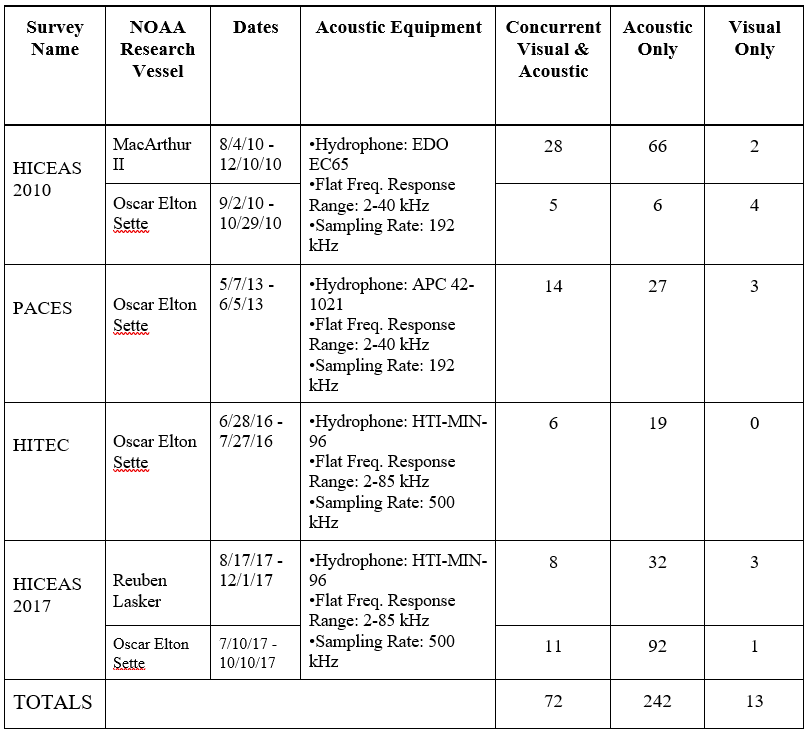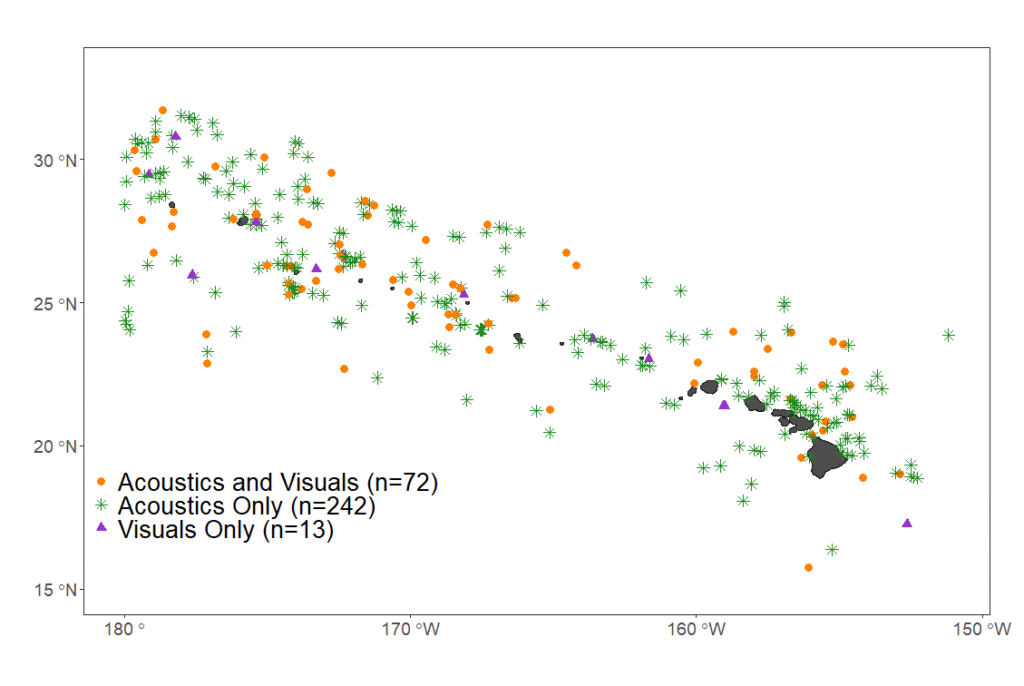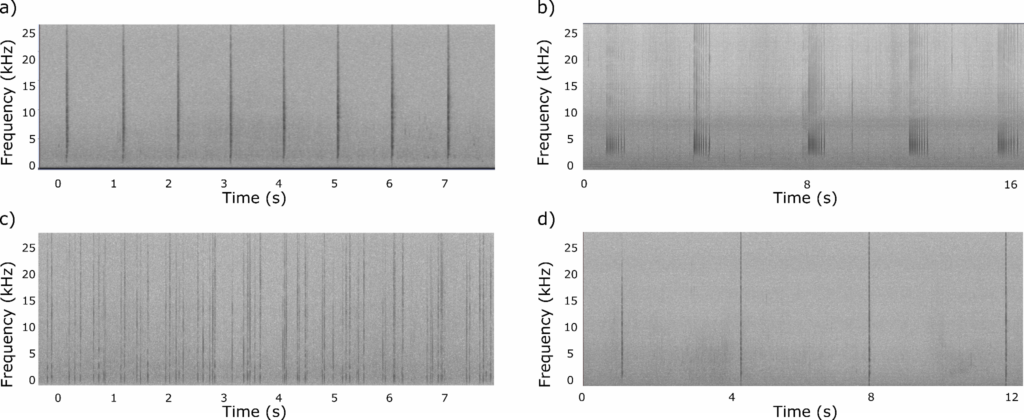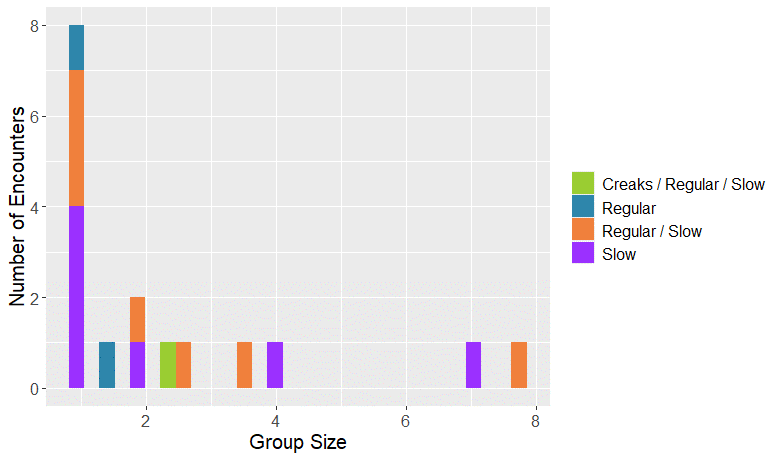Task 4c
Investigating cue-rate variability of deep-divers due to geographic region, behavioral state and group size and composition
Previous research on deep-diving cetacean species has shown that geographic differences in acoustic behavior must be considered when using acoustic cues for abundance estimation in a new region (Douglas et al. 2005, Warren et al. 2017). This task will focus on sperm whales and will utilize archived data from combined visual and acoustic surveys to assess cue rate variability in two LMR priority geographic regions. The data available include recordings from towed passive acoustic arrays, with concurrent visual sightings during daytime hours, as well as recordings from drifting passive acoustic buoys.
Team members
- Erin Oleson
- Karlina Merkens
- Yvonne Barkley
Species considered
- Sperm whale (Physeter macrocephalus)
Data available
Passive acoustic towed array data were collected as part of 5 years of visual/acoustic surveys in the Main Hawaiian Islands in the Central North Pacific Ocean. Continuous acoustic recordings were collected using custom-built hydrophone arrays (Figure 1) towed at approximately 4-10 m deep, 300 m behind the ship while traveling at 18.5 km/h (10 kt). The components of the towed hydrophone arrays and data acquisition systems varied between surveys (Table 1). During daylight hours, trained acousticians monitored the sounds aurally with headphones and visually using spectrographic software (ISHMAEL, Mellinger 2001; PAMGuard, Gillespie et al. 2008). When cetacean vocalizations were detected, a phone-pair bearing algorithm in ISHMAEL or PAMGuard was used to calculate the direction of the sound source relative to the bow of the ship. These bearings were plotted using a mapping software with a GPS interface (PAMGuard; Whaltrak, by Jay Barlow). Target motion analysis was used to estimate the perpendicular distance to the animals based on the convergence of plotted bearings with left/right ambiguity. In some cases, the ambiguity in perpendicular distances was resolved if the ship turned while the animals were still vocalizing. Acoustic encounters were linked to concurrent sightings when acoustic bearing estimates were consistent with the sighted location of the animal group (Rankin et al. 2008). When the ambiguity of the acoustic location estimate could not be resolved, the average perpendicular distance from both sides of the ship was recorded. A total of 327 acoustic encounters of sperm whales were detected. A total of 72 sperm whale encounters were concurrently detected by both visual and acoustic methods and 242 sperm whale encounters were detected by acoustic methods only, and only 13 sperm whale encounters were only detected by visual methods (Table 1, Figure 2).



Approach taken
Sperm whale echolocation clicks are identified based on their low frequency, long duration, and high amplitude characteristics. Four main click types exist, which are associated with different behaviors (Figure 3). When estimating sperm whale click rates for acoustic density estimation, it is important to consider different factors that may affect click production and detectability. Therefore, we are analyzing the data by considering the click type, the number of whales in a group, and their distance from the ship (Figure 4). Subsequently, the first set of acoustic encounters for analysis aims to minimize the impact of click detectability by only including groups of 1-2 animals producing regular and/or slow clicks located close enough to the ship where the effects of sound propagation are negligible (within 4 km). This initial subset of data will provide baseline results where we assume all clicks are detected to obtain accurate estimates of click rate, which can then be adjusted for sperm whale acoustic encounters with larger groups located farther away or in other cases where detectability may be influenced. Further analysis will also include comparing sperm whale group sizes obtained by visual observers with click rates measured from the towed array data to better understand the relationship between visual and acoustic group size estimates and between group size and click rate.


Progress

